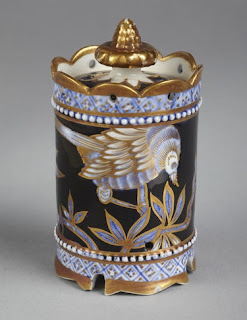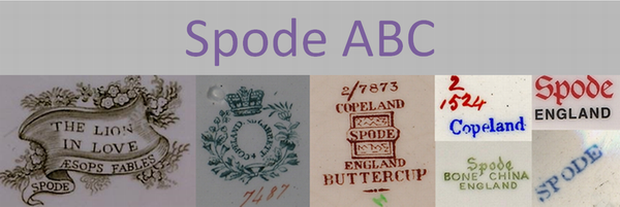 |
| Part tea service, bone china, New Oval shape, pattern 893 c1806 |
You can find out more about teapot stands by clicking Spode and a Mystery Teapot Stand
Tennis
Click here for Spode & Tennis and also here for Spode and Tennis 2013 with facts about and images of special wares made for tennis parties in the late 1800s. A beautiful tennis set is illustrated here.
The Old Bailey
See Old Bailey.
Throwing Wheel
Click here for a bit about an 18th century Spode throwing wheel.
 |
| Spode 18th century throwing wheel, detail of rope drive |
Tiles
Click here for Spode and Tiles. And here and also here where in a blog about Charles Ferdinand Hürten you can see a slab (a large tile).
 |
| Moulded tile representing Fire in situ on the Spode factory site in 2006, poor condition. Mid to late 19th century |
 |
| Random tiles covering stillages in situ on the Spode factory site in 2004 |
You can see a lovely tile from a set of months of the year by clicking Spode in January.
Titanic
Click here for Spode & RMS Titanic.
Toiletware (Toilet Ware)
You can find out a bit about toiletware on my blog Spode and Hot Water - just click here.
 |
| Part toilet set, creamware, pattern 3000, printed and hand coloured c1820 |
In the image of pattern 3000 you can see, at the back, a ewer and basin; left to right at the front, a soap box, toothbrush box and bordeloue (ladies' urinal).
 |
| Ewer, bone china, Gadroon shape, handpainted with orchids by Thomas Sadler and gilded, c1890 |
 |
| Ewer and basin, earthenware, Pompeian shape, pattern 6830 c1843, V & A collections |
 |
| Spode Bordaloue, coach pot or ladies' urinal, Italian pattern c1820 |
Tower
Click here for Spode and Tower Pattern. You can also see how the Tower border is used in conjunction with a different centre to produce magnificent dish for turkey and, yes, it does feature a turkey printed in the centre - click here.
 |
| Rouge pot about 2.5 inches high; (sometimes mistaken for a custard cup!), Tower pattern c1820 |
Trade Winds
 |
| Leaflet Trade Winds, 1960s |
Transfer Printing
This is a method of decoration on ceramics. Underglaze transfer printing in blue on earthenware is believed to have been perfected by Josiah Spode I in about 1784. It went on to be particularly successful for the Spode company and was still in use until about 2008 alongside newer methods.
You can find more information on printing and engraving by clicking here for Spode and Printing...and Hogarth. There are also links there to take you to other relevant websites. I also like this from Country Living New York magazine who I worked with a few years ago for their article on Spode - click here.
This subject is dealt with in detail in two books about Spode: 'Spode's Willow Pattern & Other designs after the Chinese' by Robert Copeland; and 'Spode Transfer Printed Ware 1784-1833' by David Drakard & Paul Holdway. For publication details go to my booklist.
Trelissick
 |
| Trelissick |
Ida Copeland gave Trelissick to the National Trust in her lifetime in 1955 - house, gardens, and estate. She continued to live there and asked the Trust to allow her family to continue to occupy the house 'as a home for my descendants' after her. She died in 1964. Click HERE> for more.
Tricorn
 |
| Cutie Kitten leaflet, 1959 |
Patterns produced on this shape included, on the plain Tricorn: Cutie Kitten with pattern number S3243 (illustrated); Barbecue with pattern numbers S3244, S3251, S3252, S3253 all recorded in 1957 (see my B page); and on the two-tone Tricorn: Chandelier with pattern number S3301; Autumn Glory with pattern number S3202 and Fascination with pattern number S3303 all recorded in 1958; Summer Days with pattern numbers S3304 and S3330 recorded in 1958 and 1959; and Wayside with pattern number S3326 also recorded in 1959.
The modern looking Tricorn shape sold well in the UK but some of the patterns were applied to the circular April shape for the more traditional Australian and New Zealand markets. Most of these patterns and the shape were discontinued in the 1960s.
 |
| Autumn Glory pattern |
Tumbledown Dick pattern was first recorded in about 1820 with pattern number 2987. The pattern is a copy, or close representation, of a Chinese porcelain design of the Yung Cheng period (1723-1735).
The pattern was produced by Spode in many different coloured versions. It was often printed and then hand coloured. It was also printed, then painted with 'ackey' (a water soluble resist) which allowed the pattern to remain unaffected when a subsequent transfer print of a 'sheet pattern' (see the S page on this blog) was applied over the whole surface. At the 'washing-off' stage (when the transfer paper is removed) the areas of the transferred sheet pattern which were over the 'ackey' were washed away leaving the outline of the first pattern. This could then be hand coloured after the glost firing. Quite a complicated technique.This technique was used for a number of patterns when a combination of prints was used. Tumbledown Dick was often used in conjunction with Marble Sheet as in pattern 3716 of 1823 in the image. See also 'Spode and Cracked Ice and Prunus' for more on marble sheet.
 |
| Sauce tureen & lid (detail), Tumbledown Dick, pattern 3716 c1823 |
A very stylish version of the pattern the pattern came to light recently kindly sent to me by D. McQuillan. This is recorded as pattern number 3086 first introduced in about 1821. The colour combination is quite stunning. The pattern is printed in outline and then the colours are hand painted and gilded. An expensive combination, not just because of the gold, but the crimson colour was a derivative of gold. It is all set off with the beautiful green ground. Here we have just one plate but imagine this as a full dessert set with comport and serving dishes, sugar and cream tureens, all lit by candlelight...
 |
| Dessert plate, Tumbledown Dick, pattern 3086 c1821 |
 |
| Backstamps on plate in pattern 3086 |
Another version of this design has pattern number 3967 of c1824. Here it is on an incense burner. Again beautiful gilded detail. You can find more about an incense burners on the I page.
 |
| 'Beaded Upright Scollopd Incense Burner' Tumbledown Dick, pattern number 3967 c1824 |
Turkey Dishes
 |
| Turkey dish, 1965 catalogue |
Click here for Spode and Turkey.
Velamour
Click Velamour which will take you to my Spode and Dogs blog which will give you more information about the Velamour range. Also go to my N-O page for entries under Olsen and Onyx; for another matt glaze of the same period go to my blog Spode and Royal Jade.
 |
| Logo from brochure, 1950s |
 |
| Leaflet, 1963 |
Vietnamese Limepot
For information about this very specific item made for use in Vietnam between 1833 and 1847 please click here>
 |
| Copeland & Garrett Vietnamese limepot, pattern B593 c1839 |
